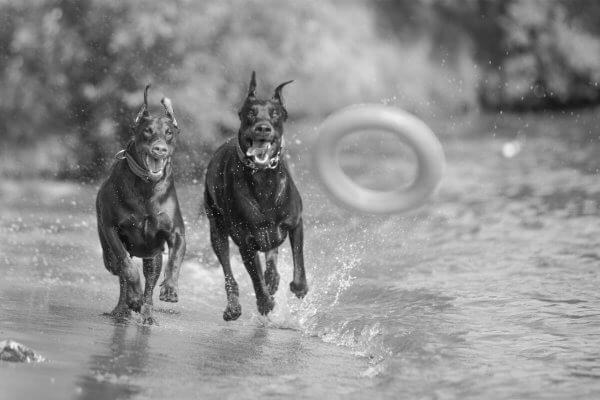
The Doberman Pinscher By Your Side
The Doberman Pinscher is a loyal hero, serving in WWII, therapy roles, and more, with unwavering devotion to its people.
Home » Meet The Breeds » Doberman Pinscher
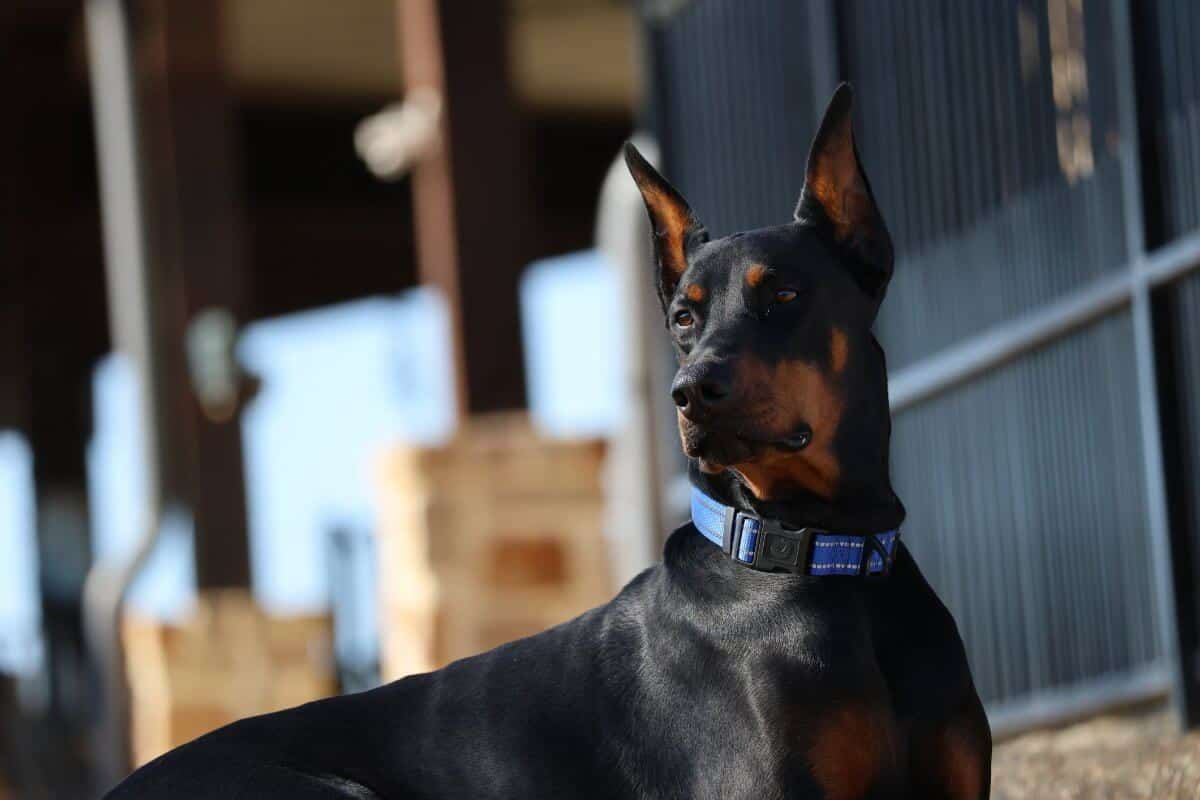
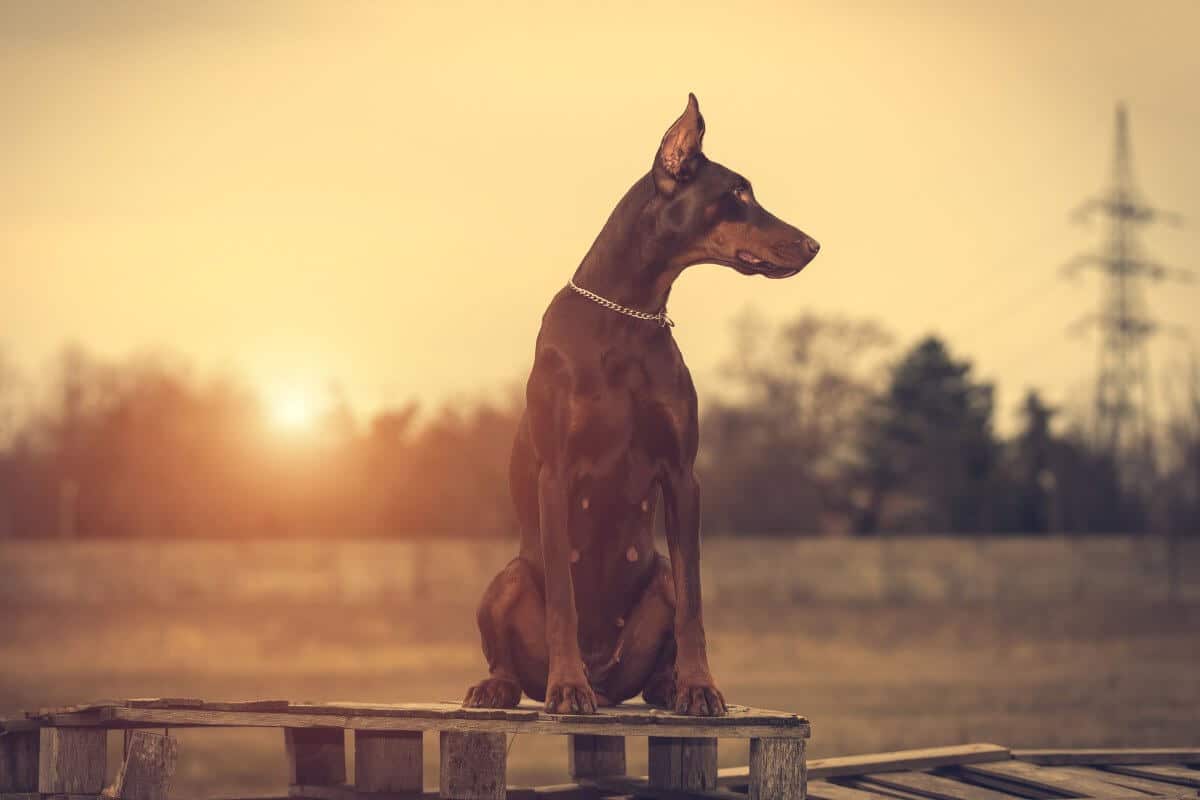

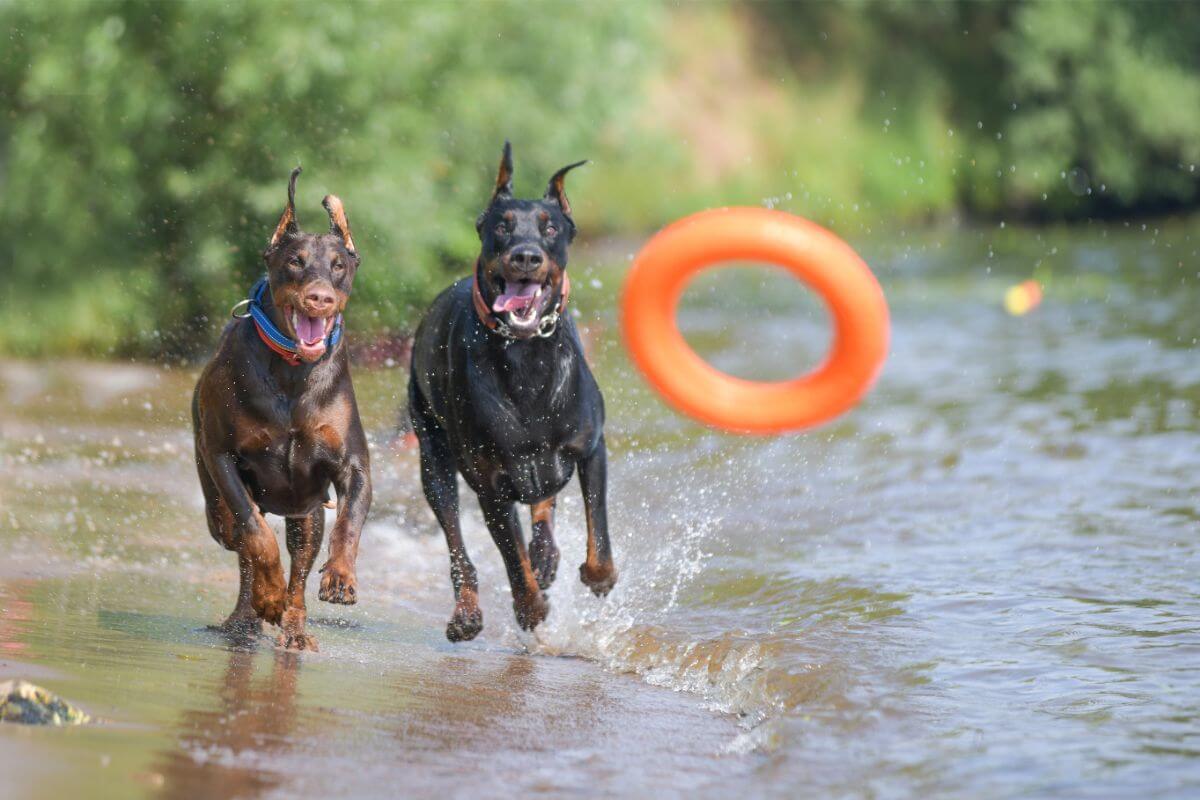
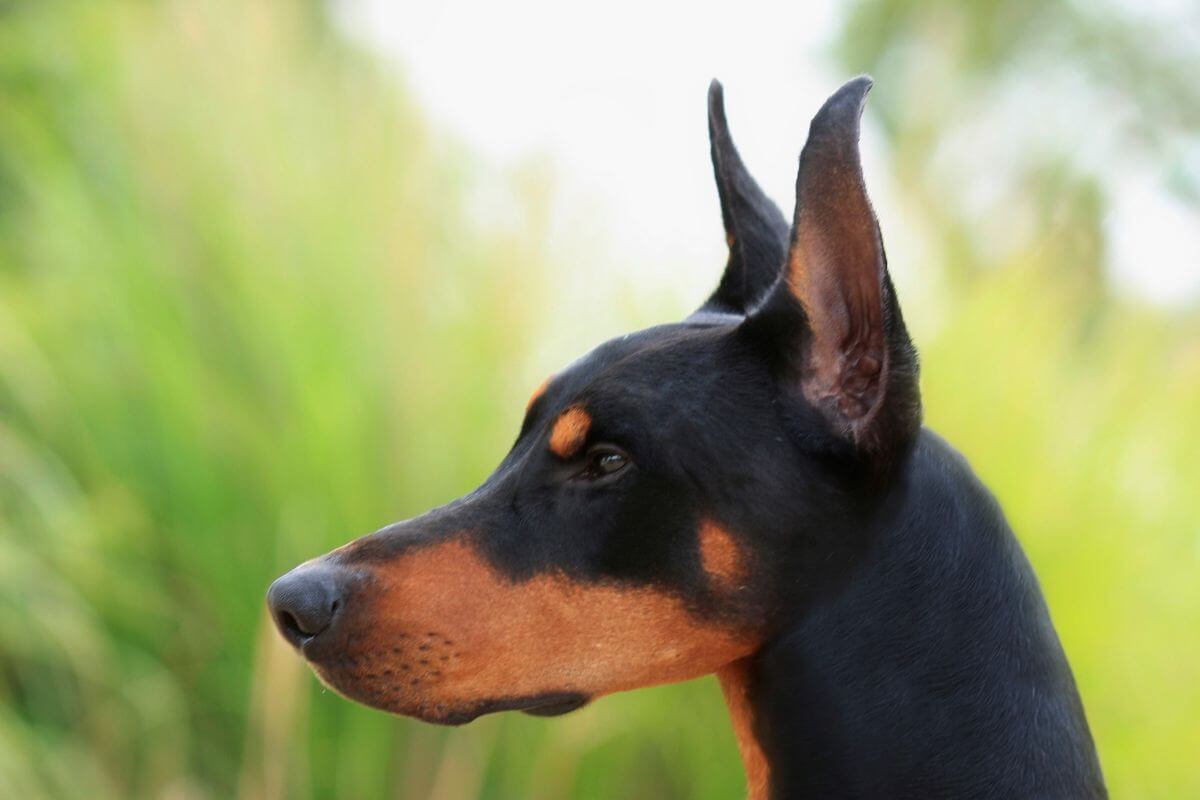
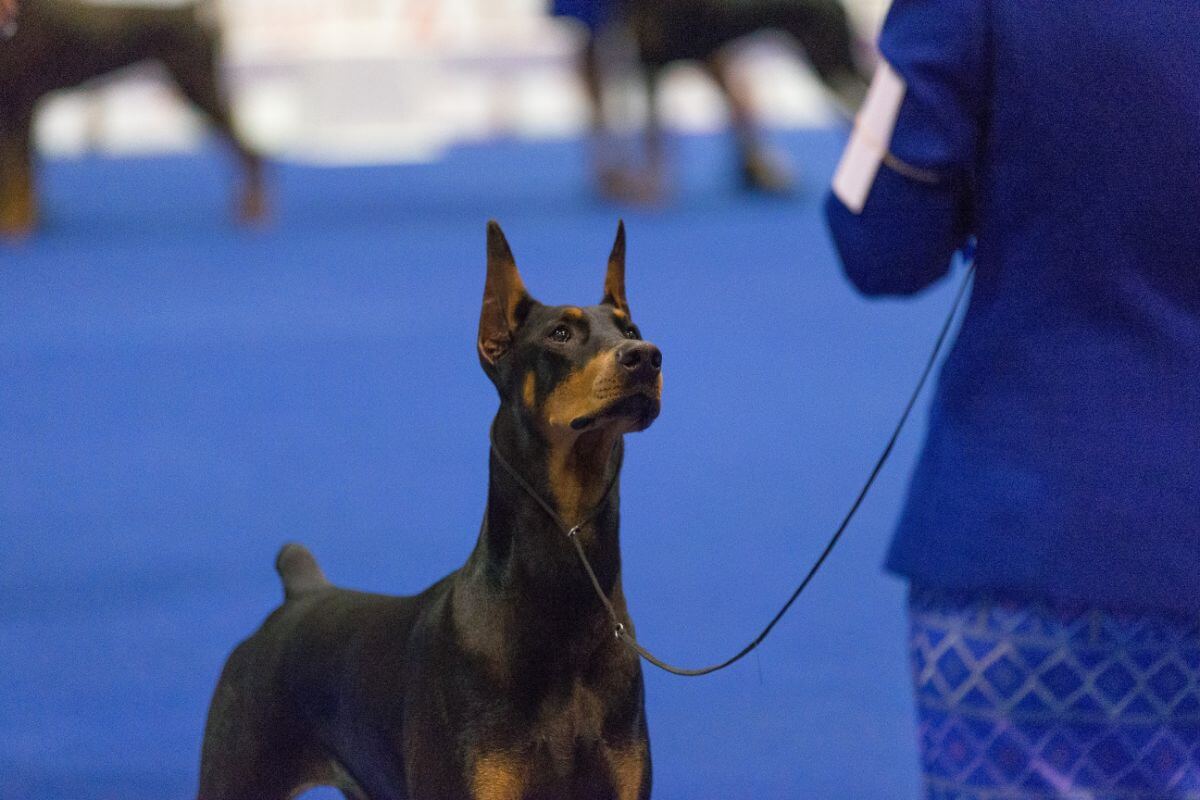
The Doberman Pinscher is a sleek and athletic working breed known for its intelligence, loyalty, and versatility. Originally bred for personal protection, this energetic and courageous dog has since excelled in a variety of roles, from law enforcement to family companionship.
Working
24 – 28 inches
60 – 100 pounds
10 – 12 years
| Country of Origin | Germany |
|---|---|
| Bred For | Companionship, Protection, Versatility |
| Known For | Elegant Appearance, Loyalty, Protectiveness |
| Popularity | High |
| Temperament | Alert, Fearless, Loyal, Watchful |
| Activities | Guarding, Police Dog, Conformation Shows, Dog Sports |
The Doberman Pinscher’s origins trace back to late 19th-century Germany, where a tax collector named Karl Friedrich Louis Dobermann sought to create a breed that could provide him with both companionship and protection during his rounds. Dobermann, who also served as a dogcatcher, had access to various breeds and selectively combined traits to achieve the ideal guardian.
Although the exact combinations are undocumented, it is widely believed that the Doberman Pinscher was developed using the German Pinscher, Rottweiler, Weimaraner, and possibly other breeds like the Greyhound and Manchester Terrier. These selections contributed to the Doberman’s hallmark traits: intelligence, agility, strength, and loyalty.
The breed quickly gained recognition for its utility, excelling as a personal protector and working dog. Its prowess in guarding and service tasks led to its adoption by law enforcement and military forces worldwide. Dobermans were notably used during World War I and World War II for tasks such as sentry duty, message delivery, and locating wounded soldiers on the battlefield. Their keen intelligence and bravery earned them the reputation as “Devil Dogs” during their military service.
In 1900, the Doberman Pinscher was officially recognized by the German Kennel Club (Deutscher Hundestammbuch), solidifying its place as a distinct breed. The American Kennel Club (AKC) followed suit in 1908, recognizing the Doberman as a member of the Working Group. The breed has since become a favorite in both Conformation shows and Performance events, showcasing its elegance and versatility.
In the United Kingdom, the Doberman Pinscher was officially recognized by The Kennel Club in 1948. The Fédération Cynologique Internationale (FCI), which consolidates Breed Standards internationally, recognizes the “Dobermann” as well, following the Breed Standard established in its country of origin, Germany.
While the breed was originally known as the “Dobermann,” the name underwent slight changes as it spread to English-speaking countries. In the United States, the name was shortened to “Doberman Pinscher,” with “Pinscher” referring to its somewhat terrier-like qualities. However, in other parts of the world, such as Europe, the breed is commonly referred to simply as the “Dobermann.”
The Doberman Pinscher is a medium to large breed, with males standing between 26 and 28 inches tall at the shoulder and weighing approximately 75 to 99 pounds. Females are slightly smaller, measuring 24 to 26 inches in height and weighing around 60 to 77 pounds.
The Doberman Pinscher is a well-balanced dog, with a square build that conveys both power and elegance. The body is compact, with a strong, muscular frame that allows for agility and endurance. Its neck is firm and well-arched, blending smoothly into a level topline, which slopes slightly from the withers to the croup. Proportion and substance are essential to the breed’s functional and aesthetic appeal, reflecting its origins as a stylish and versatile working dog.
Texture: The Doberman Pinscher’s coat is smooth, short, and lies close to the body, giving the breed a sleek and polished appearance. The coat is firm to the touch and requires minimal grooming to maintain its natural shine.
| Standard Color | |
|---|---|
| Black & Rust | n |
| Blue & Rust | n |
| Fawn (Isabella) & Rust | n |
| Red & Rust | n |
| White | n |
| Standard Marking | |
|---|---|
| Rust-colored Markings | n |
A Note About Color: On black, red, blue, and fawn-colored Dobermans, the markings are sharply defined and appear above both eyes and on the muzzle, throat, and forechest, on all legs and feet, and below the tail. A white patch on the chest, not exceeding one-half inch is acceptable, but white dogs, and dogs of any other color, are not.
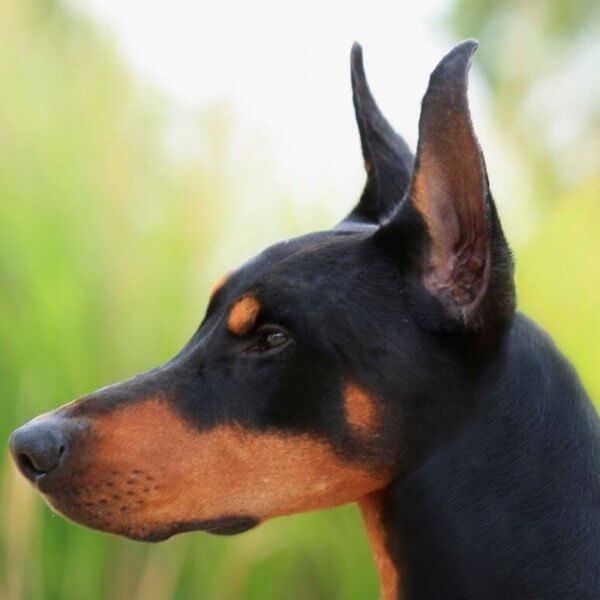
The Doberman Pinscher’s tail is typically docked at about the second joint, creating a short and distinct appearance that enhances the breed’s sleek and athletic outline. It is carried only slightly above the horizontal when the dog is alert. In countries where tail docking is prohibited, the tail is left natural, ideally carried high in a slight curve.
The Doberman Pinscher is a loyal, intelligent, and protective breed that thrives in active households. Understanding its health, training, and exercise needs is essential to raising a happy and well-adjusted companion.
The Doberman Pinscher is a reasonably healthy breed with a lifespan of 10 to 12 years. However, like all dogs, individuals may experience certain breed-specific health concerns.
Doberman Pinschers can be prone to several health issues, including:
The Doberman Pinscher is known for its intelligence, loyalty, and protective nature, making it an exceptional family companion and watchdog. This breed is highly sensitive and thrives in homes where it can form strong bonds with its human companions. While Dobermans are generally affectionate with their favorite people, they may be reserved or cautious around strangers, showcasing their natural guarding instincts.
Dobermans are typically good with children when properly socialized, displaying patience and a playful demeanor. They can get along well with other dogs, but early socialization is crucial to prevent assertive or combative tendencies. Due to their loyal and people-oriented nature, they do not do well when left alone for long periods and may develop separation anxiety.
Doberman Pinschers require a high-quality, well-balanced diet to maintain their athletic build and high energy levels. Puppies should be fed a specially formulated puppy food to support their growth and development. It’s important to monitor portion sizes to prevent overfeeding, as rapid weight gain can put undue stress on developing joints.
Adult Dobermans typically require 2 to 3 cups of food per day, divided into two meals. The exact amount depends on their age, size, metabolism, and activity level. Feeding schedules should be consistent, and access to fresh water should always be provided. Owners should avoid feeding Dobermans immediately before or after vigorous exercise to minimize the risk of gastric dilatation-volvulus (bloat).
The Doberman Pinscher is highly intelligent and eager to please, making it one of the most trainable of all breeds. Early and consistent training is essential to shape behavior, and positive reinforcement techniques, such as treats and praise, work particularly well.
Dobermans are quick learners but can become bored with repetitive tasks, so training sessions should be engaging and varied. They have a strong protective instinct and need to be socialized early to differentiate between normal and threatening situations. While they tend to bark when alerting to perceived threats, excessive barking can be managed with proper training.
This breed has a high prey drive and may chase small animals if not properly trained to focus. The intelligence and drive of these dogs allow them to excel in advanced Obedience, Agility, and other dog sports. With firm yet gentle guidance, the Doberman Pinscher can develop into a well-mannered, obedient, and accomplished companion.
The Doberman Pinscher is an energetic and athletic breed that requires ample daily exercise to remain healthy and happy. A minimum of one to two hours of physical activity is recommended, including brisk walks, jogging, or interactive play sessions. This breed thrives on activities that challenge both body and mind, such as Agility training, Obedience exercises, or games of fetch.
| Energy Level | High |
|---|---|
| Exercise Requirements | 70 Minutes/Day (Minimum), Daily Walks, Vigorous Running, Regular Exercise, Mental Stimulation |
Dobermans have a high energy level and a particular intensity, making them well-suited for active and experienced families or individuals. Without sufficient exercise, they can become bored and engage in destructive behaviors. Regular outdoor activities combined with games of mental stimulation help to keep this elegant athlete physically fit and mentally satisfied.
The Doberman Pinscher’s grooming needs are minimal due to its short, sleek coat. Weekly brushing with a rubber curry brush or grooming glove is sufficient to remove loose hair and maintain the coat’s natural shine. The breed has a moderate shedding level, but regular grooming is helpful for removing the dander.
| Coat Type | Close-lying, Short, Smooth, Hard |
|---|---|
| Grooming Requirements | Weekly Brushing, Occasional Bathing, Routine Ear Cleaning, Periodic Nail Trimming, Regular Tooth Brushing |
Dobermans are considered easy to groom, requiring only occasional baths to keep their coat clean. Routine care also includes trimming nails, cleaning ears, and brushing teeth to prevent dental issues.
Doberman Pinschers are adaptable dogs, but their size and energy make them better suited for homes with space to run around and play. They can live in apartments if given enough daily exercise, but a home with a securely fenced yard is ideal.
This breed is sensitive to extreme temperatures. Dobermans tolerate cold weather poorly due to their short coat and may require a sweater or jacket in cooler climates. In hot weather, they should be provided with shade and water to avoid overheating.
Dobermans are highly people-oriented and thrive when included in family activities. Their loyalty, intelligence, and protective instincts make them excellent companions for the right household, but they require a committed and attentive owner to meet their physical and emotional needs.
Doberman Pinscher puppies are curious, energetic, and quick learners. Early socialization and consistent training are key to shaping their behavior, while proper puppy nutrition supports healthy growth.
Caring for a Doberman Pinscher puppy starts with providing a safe and structured environment. The Dobie pup is naturally inquisitive and can easily get into mischief, so it’s essential to puppy-proof the home to protect the puppy from hazards and discourage destructive behaviors.
Socialization is a top priority for the Doberman puppy. Exposing the newest family member to a variety of people, environments, and animals during the early weeks helps to prevent fearfulness or aggression later in life. Puppy classes or structured playdates are excellent opportunities to build confidence and reinforce positive behaviors.
Feeding a high-quality puppy food specifically designed for large-breed puppies is crucial to support rapid growth. Meals should be given in measured portions to prevent overfeeding, which can lead to joint problems. A puppy typically needs three to four small meals a day, transitioning to two meals as it matures.
Housetraining is an essential early step in a Doberman puppy’s development, as is introducing a crate as a safe place to rest and sleep. Consistency and patience are key to teaching proper behavior, and positive reinforcement methods work best for this intelligent breed. Regular veterinary checkups and communication with the puppy’s breeder are also vital during the first year.
The Doberman Pinscher is recognized by the world’s leading registries and kennel organizations, which categorize the breed into a specific Group based on its unique characteristics. This breed is recognized worldwide under the following Group designations:
| Organization | Group Designation |
|---|---|
| AKC (American Kennel Club) | Working |
| UKC (United Kennel Club) | Guardian |
| CKC (Canadian Kennel Club) | Working |
| ANKC (Australian National Kennel Council) | Utility |
| RKC (The Royal Kennel Club) | Working |
| FCI (Fédération Cynologique Internationale) | Group 2: Pinscher and Schnauzer Molossoid Breeds – Swiss Mountain and Cattle Dogs; Section 1: Pinscher and Schnauzer |
The ideal Doberman Pinscher is described by a Breed Standard that is approved by each of the world’s leading registries and kennel organizations. The Breed Standards for this breed may be found in the following links:
| Organization | Breed Standard |
|---|---|
| American Kennel Club | AKC Doberman Pinscher Breed Standard |
| United Kennel Club | UKC Doberman Pinscher Breed Standard |
| Canadian Kennel Club | CKC Doberman Pinscher Breed Standard |
| Australian National Kennel Council | ANKC Doberman Pinscher Breed Standard |
| The Royal Kennel Club | RKC Doberman Pinscher Breed Standard |
| Fédération Cynologique Internationale | FCI Doberman Pinscher Breed Standard |
Yes, Doberman Pinschers shed, but their short, sleek coat makes the shedding less noticeable compared to breeds with longer hair. Regular brushing helps to minimize the loose hair and keeps the coat shiny.
No, Dobermans are not hypoallergenic. While they shed minimally, their dander can still trigger allergies in sensitive individuals.
Doberman Pinschers typically live between 10 to 12 years. A healthy lifestyle and regular veterinary care can help them reach the upper end of this range.
Yes, Doberman Pinschers are excellent family dogs, known for their loyalty and protective nature. They bond deeply with their families and are generally affectionate and good with children when properly trained and socialized.
Doberman Pinschers are naturally alert and will bark to warn their owners of potential threats. However, with proper training, any tendency towards excessive barking can usually be managed.

The Doberman Pinscher is a loyal hero, serving in WWII, therapy roles, and more, with unwavering devotion to its people.
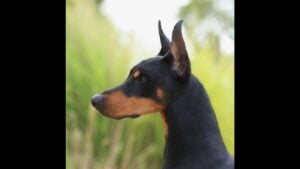
Learn the proper method to evaluate the Doberman’s mouth, including teeth count, occlusion, and disqualification criteria.

Meet Leona Sibo, a passionate Breeder/Owner Handler shaping Dobermans and mentoring the next generation in the dog show world.
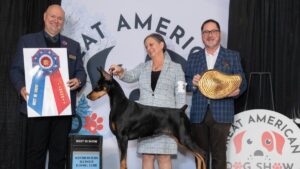
Leona Sibo of Denali Dobermans shares her passion for breeding healthy, functional Dobermans with purpose, heart, and integrity.

Veterinarian Dr. Renato Mendez shares his lifelong passion for ethical Doberman breeding, canine health, and breed preservation.

Theresa Connors of ConnQuest Dobermans shares insights on breeding, tradition, and preserving the proud look of the Doberman.

Jim & Ann White are breeders behind Cambria Doberman Pinschers. Read about the kennel’s beginnings, Doberman Pinscher puppies, and much more!
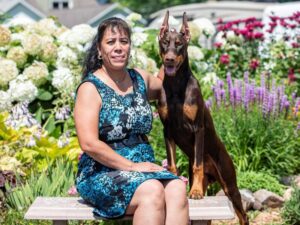
Linda Vinson is breeder behind Rockhill Dobermans. Read about the kennel’s beginnings, the puppies, and much more!
The best way to ensure a long and happy relationship with a purebred dog is to purchase one from a responsible breeder. Not sure where to begin?
Contact the National Parent Club’s Breeder Referral Program, which is listed on the AKC Breeder Referral Contacts page.
